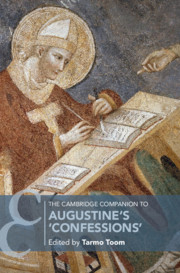Book contents
- The Cambridge Companion to Augustine’s Confessions
- Cambridge Companions to Religion
- The Cambridge Companion to Augustine’s Confessions
- Copyright page
- Contents
- Contributors
- Acknowledgments
- Abbreviations
- Introduction
- Part I Circumstances of Composition
- 1 Title, Time, and Circumstances of Composition
- 2 Structure and Genre of the Confessions
- 3 Anticipated Readers
- Part II Main Themes and Topics
- Part III Reception and Reading Strategies
- A Bibliographical Note
- Index
- Other Titles in the Series (continued from page ii)
- References
2 - Structure and Genre of the Confessions
from Part I - Circumstances of Composition
Published online by Cambridge University Press: 22 February 2020
- The Cambridge Companion to Augustine’s Confessions
- Cambridge Companions to Religion
- The Cambridge Companion to Augustine’s Confessions
- Copyright page
- Contents
- Contributors
- Acknowledgments
- Abbreviations
- Introduction
- Part I Circumstances of Composition
- 1 Title, Time, and Circumstances of Composition
- 2 Structure and Genre of the Confessions
- 3 Anticipated Readers
- Part II Main Themes and Topics
- Part III Reception and Reading Strategies
- A Bibliographical Note
- Index
- Other Titles in the Series (continued from page ii)
- References
Summary
This chapter highlights the challenges of understanding the generic make-up of the “Confessions” by looking at issues like “the unity” of the “Confessions” and various suggestions and difficulties involved in describing its structure and its genre. The section on structure focuses mostly on various ways of categorizing the units of content within the work, including a concise overview of a variety of proposals that have been made in this regard. The section on genre highlights the generic labels that are most frequently attached to the work (like autobiography, exegesis, protreptic, or apologetic), suggests some others, and also points toward the innovative fusion of antecedent generic conventions that constitutes the “Confessions.”
Keywords
- Type
- Chapter
- Information
- The Cambridge Companion to Augustine's 'Confessions' , pp. 28 - 45Publisher: Cambridge University PressPrint publication year: 2020
References
Further Reading
- 1
- Cited by



